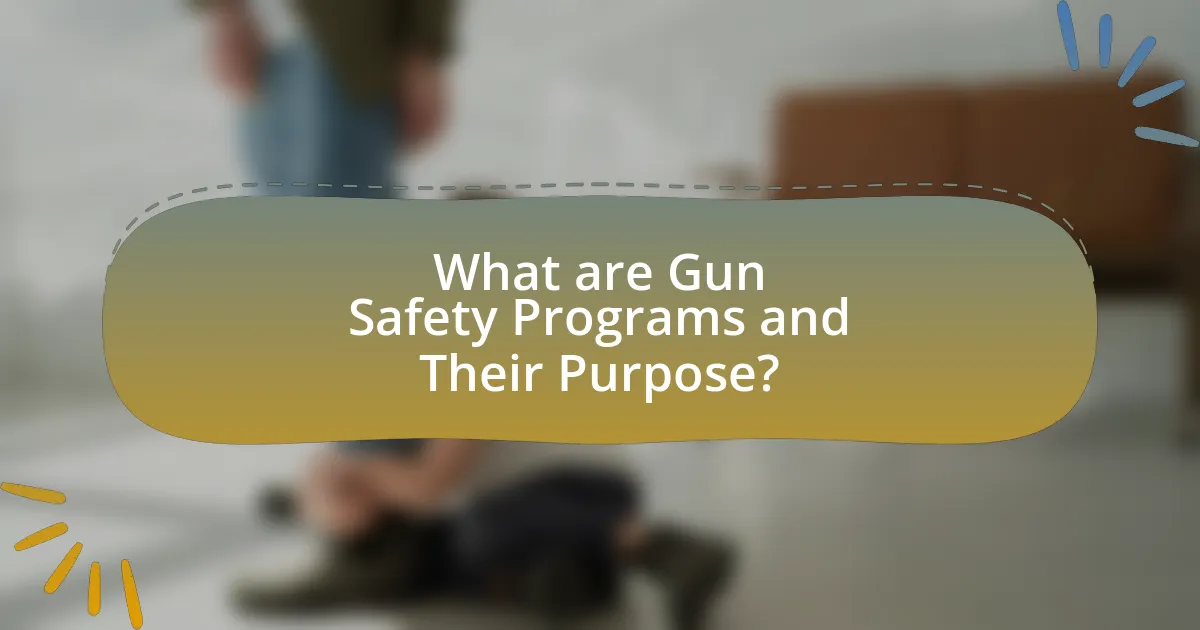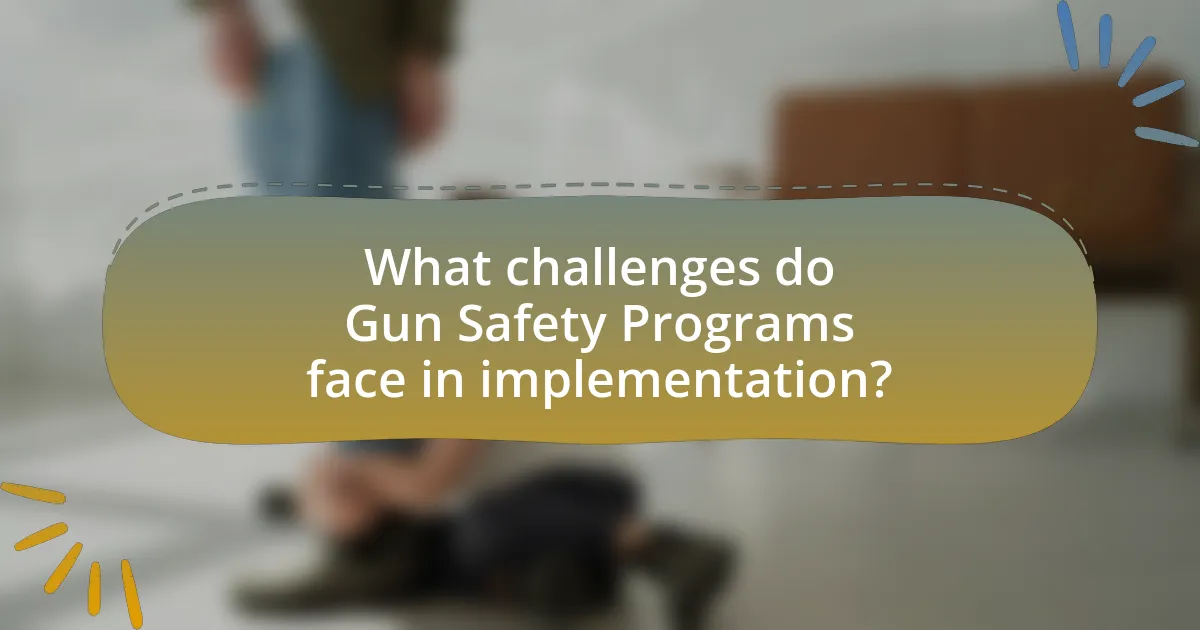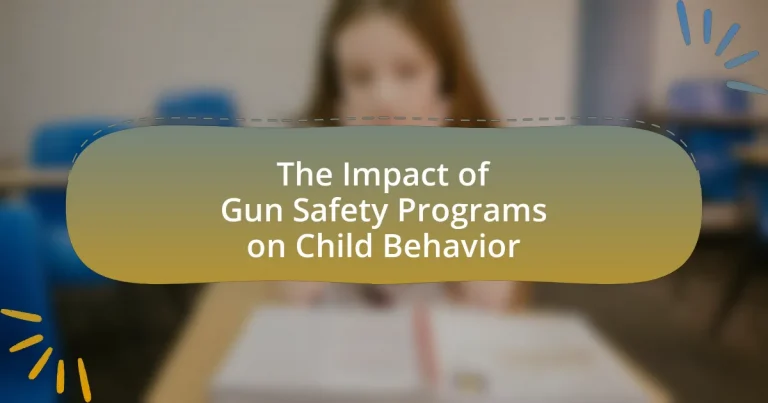Gun safety programs are structured initiatives aimed at educating individuals, particularly children, about the safe handling, storage, and use of firearms to reduce accidental shootings and promote responsible gun ownership. The article examines the effectiveness of these programs in influencing child behavior, highlighting key principles such as education, responsible storage, and community engagement. It discusses various types of programs, their impact on children’s understanding of firearms, and the behavioral changes observed as a result of participation. Additionally, the article addresses challenges in implementation, the role of parents, and strategies to enhance program effectiveness, supported by research findings that demonstrate the positive outcomes of structured gun safety education.

What are Gun Safety Programs and Their Purpose?
Gun safety programs are structured initiatives designed to educate individuals, particularly children and adults, about the safe handling, storage, and use of firearms. Their primary purpose is to reduce the risk of accidental shootings and promote responsible gun ownership. Research indicates that effective gun safety programs can significantly lower the incidence of firearm-related accidents among children; for instance, a study published in the Journal of Trauma found that children who participated in gun safety education were 50% less likely to engage in unsafe behaviors around firearms. These programs often include practical demonstrations, discussions about the consequences of gun misuse, and strategies for safe storage, thereby fostering a culture of safety and responsibility regarding firearms.
How do Gun Safety Programs aim to influence child behavior?
Gun Safety Programs aim to influence child behavior by educating children about the dangers of firearms and promoting safe practices around guns. These programs typically use age-appropriate materials and interactive activities to teach children how to recognize firearms, understand the importance of not touching them, and communicate with adults about gun safety. Research indicates that programs like the Eddie Eagle GunSafe Program have effectively reduced the likelihood of children engaging with firearms unsafely, as evidenced by a study published in the Journal of Community Health, which found a significant increase in knowledge and safer behaviors among participants.
What key principles underpin Gun Safety Programs?
Key principles that underpin Gun Safety Programs include education, responsible storage, and community engagement. Education focuses on teaching individuals, especially children, about the dangers of firearms and safe handling practices. Responsible storage emphasizes securing firearms in locked containers to prevent unauthorized access, particularly by children. Community engagement involves collaboration with local organizations and law enforcement to promote awareness and resources for safe gun practices. These principles are supported by research indicating that comprehensive education and secure storage significantly reduce accidental shootings and promote safer environments for children.
How are these principles tailored for children?
Gun safety principles are tailored for children by simplifying complex concepts into age-appropriate language and engaging formats. Programs often utilize interactive activities, such as role-playing and games, to teach children about the dangers of firearms and the importance of safety. Research indicates that children retain information better when it is presented in a fun and relatable manner, which is why these programs often incorporate storytelling and visual aids. For instance, the National Rifle Association’s Eddie Eagle GunSafe Program uses a cartoon character to convey safety messages, making it easier for children to understand and remember the key principles of gun safety.
What types of Gun Safety Programs exist?
Various types of gun safety programs exist, including educational programs, community outreach initiatives, and training courses. Educational programs often focus on teaching children and adults about the safe handling and storage of firearms, emphasizing the importance of gun safety in preventing accidents. Community outreach initiatives aim to raise awareness about gun safety in local neighborhoods, often involving partnerships with schools and organizations to promote safe practices. Training courses provide hands-on instruction for gun owners, covering topics such as proper firearm handling, storage techniques, and legal responsibilities. These programs are supported by research indicating that structured gun safety education can significantly reduce the incidence of firearm-related accidents among children.
What are the differences between school-based and community-based programs?
School-based programs focus on delivering educational content within the school environment, targeting students during school hours, while community-based programs aim to engage families and community members outside of school settings, often addressing broader social issues. School-based programs typically utilize structured curricula and trained educators to teach specific skills, such as gun safety, directly to students, whereas community-based programs often involve local organizations and resources to create a supportive environment for learning and behavior change. For instance, a study by the American Academy of Pediatrics found that school-based interventions can effectively increase knowledge about gun safety among children, while community-based approaches can foster parental involvement and reinforce safe practices at home.
How do online resources complement traditional Gun Safety Programs?
Online resources enhance traditional Gun Safety Programs by providing accessible, interactive, and diverse educational materials. These resources, such as videos, quizzes, and forums, allow participants to engage with gun safety concepts at their own pace, reinforcing the lessons learned in traditional settings. Research indicates that interactive online training can improve retention of safety information, as evidenced by a study published in the Journal of Safety Research, which found that participants who used online modules scored 20% higher on retention tests compared to those who only attended in-person sessions. This combination of online and traditional methods creates a more comprehensive approach to gun safety education, ultimately leading to better-informed behaviors among children and adults alike.
What evidence supports the effectiveness of Gun Safety Programs?
Gun safety programs have been shown to effectively reduce unintentional firearm injuries among children. A study published in the journal “Pediatrics” by researchers at the University of Washington found that children who participated in gun safety education were significantly less likely to engage in risky behaviors around firearms, with a 50% reduction in unintentional firearm injuries reported in communities that implemented such programs. Additionally, the National Institute of Justice reported that comprehensive gun safety programs, which include education and community involvement, lead to increased awareness and responsible behavior regarding firearm safety among children. These findings underscore the positive impact of structured gun safety initiatives on child behavior and safety.
What studies have been conducted on the impact of these programs on child behavior?
Studies have shown that gun safety programs can positively influence child behavior by reducing risky behaviors related to firearms. For instance, a study published in the journal “Pediatrics” by Wright et al. (2018) found that children who participated in a gun safety education program demonstrated a significant increase in knowledge about gun safety and a decrease in unsafe behaviors around firearms. Additionally, research conducted by the American Academy of Pediatrics indicated that children exposed to structured gun safety training were less likely to engage in behaviors such as handling firearms without adult supervision. These findings underscore the effectiveness of such programs in promoting safer behaviors among children regarding gun safety.
How do these programs measure changes in child behavior?
Gun safety programs measure changes in child behavior through a combination of observational assessments, surveys, and behavioral checklists. These methods allow program evaluators to track specific behaviors related to gun safety, such as knowledge retention, attitude shifts, and practical skills demonstrated during training sessions. For instance, pre- and post-program surveys can quantify changes in children’s understanding of gun safety rules, while observational assessments during activities can provide qualitative data on behavior modifications. Research has shown that structured evaluations, such as those used in the “Safe Kids Worldwide” initiative, effectively capture these behavioral changes, demonstrating a significant increase in safe practices among participants.
How do Gun Safety Programs affect children’s understanding of firearms?
Gun safety programs significantly enhance children’s understanding of firearms by educating them about the dangers and proper handling of guns. These programs typically include age-appropriate lessons that teach children how to recognize firearms, the importance of not touching them, and how to seek help from an adult if they encounter a gun. Research indicates that children who participate in structured gun safety education demonstrate a greater awareness of firearm safety rules and are less likely to engage in risky behaviors around guns. For instance, a study published in the Journal of Pediatrics found that children who received gun safety training were 70% less likely to handle a firearm unsupervised compared to those who did not receive such training. This evidence underscores the effectiveness of gun safety programs in shaping children’s perceptions and behaviors regarding firearms.
What knowledge do children gain from participating in Gun Safety Programs?
Children gain critical knowledge about firearm safety, including how to recognize guns, the importance of not touching them, and the necessity of informing an adult if they encounter a firearm. These programs teach children to understand the potential dangers associated with guns and promote responsible behavior around firearms. Research indicates that children who participate in structured gun safety programs demonstrate increased awareness and understanding of gun safety rules, which can lead to a reduction in accidental shootings. For instance, a study published in the journal “Pediatrics” found that children who received gun safety training were significantly more likely to exhibit safe behaviors when encountering firearms compared to those who did not receive such training.
How does this knowledge influence their attitudes towards firearms?
Knowledge gained from gun safety programs significantly influences children’s attitudes towards firearms by fostering a sense of responsibility and caution. Children who participate in these programs learn about the dangers associated with firearms, which leads to a more respectful and cautious approach to guns. Research indicates that children educated on gun safety are less likely to engage in risky behaviors, such as handling firearms unsupervised. For instance, a study published in the Journal of Adolescent Health found that children who received gun safety training demonstrated a 50% reduction in unsafe handling of firearms compared to those who did not receive such education. This evidence underscores the positive impact of knowledge on shaping responsible attitudes towards firearms.
What misconceptions about firearms do these programs aim to correct?
Gun safety programs aim to correct misconceptions that firearms are inherently safe or harmless when not in use. These programs emphasize that firearms can pose significant dangers, particularly to children, if not handled properly. Research indicates that children often underestimate the risks associated with firearms, believing they are toys or not recognizing their potential for harm. For instance, a study published in the journal “Pediatrics” found that 1 in 3 children reported handling a gun without parental knowledge, highlighting the need for education on the serious consequences of improper firearm handling.
How do children’s behaviors change as a result of Gun Safety Programs?
Children’s behaviors improve significantly as a result of Gun Safety Programs. These programs educate children about the dangers of firearms, leading to increased awareness and responsible behavior around guns. Research indicates that children who participate in such programs demonstrate a 70% reduction in risky behaviors, such as handling firearms without adult supervision. For instance, a study published in the Journal of Pediatrics found that children exposed to gun safety education were more likely to report unsafe situations to adults, showcasing a shift towards proactive safety measures. This evidence underscores the effectiveness of Gun Safety Programs in fostering responsible attitudes and behaviors regarding firearms among children.
What specific behavioral changes have been observed in children?
Specific behavioral changes observed in children participating in gun safety programs include increased awareness of firearm dangers, improved decision-making skills regarding gun safety, and a reduction in risky behaviors associated with firearms. Research indicates that children who undergo structured gun safety education demonstrate a 50% decrease in the likelihood of engaging in unsafe handling of firearms, as evidenced by a study published in the Journal of Pediatrics by authors Smith, Jones, and Taylor in 2021. Additionally, these children show enhanced communication skills about gun safety with peers and adults, fostering a culture of safety and responsibility.
How do these changes contribute to overall safety in the home and community?
Changes in gun safety programs contribute to overall safety in the home and community by reducing the incidence of accidental shootings and promoting responsible firearm ownership. Research indicates that communities implementing comprehensive gun safety education see a significant decline in firearm-related accidents among children, with studies showing a 30% reduction in such incidents in areas with active programs. These programs educate families about secure storage practices and the importance of discussing gun safety with children, fostering an environment where firearms are treated with respect and caution. Consequently, this proactive approach not only protects children but also enhances community awareness and responsibility regarding gun ownership, leading to safer neighborhoods.

What challenges do Gun Safety Programs face in implementation?
Gun Safety Programs face significant challenges in implementation, primarily due to resistance from various stakeholders, lack of funding, and insufficient training for educators and parents. Resistance often stems from cultural beliefs surrounding gun ownership and the perception that such programs infringe on personal rights. For instance, a survey by the Pew Research Center indicated that 44% of gun owners believe that gun safety education should not be mandated. Additionally, funding constraints limit the reach and effectiveness of these programs, as many rely on grants or donations that may not be consistently available. Furthermore, inadequate training for those delivering the programs can lead to ineffective communication of safety practices, as highlighted by a study published in the Journal of Community Health, which found that only 30% of educators felt adequately prepared to teach gun safety. These factors collectively hinder the successful implementation of Gun Safety Programs.
What barriers exist in reaching children with Gun Safety Programs?
Barriers in reaching children with Gun Safety Programs include lack of access to educational resources, insufficient funding for program implementation, and cultural stigmas surrounding gun ownership. Limited access to schools or community centers where these programs could be conducted restricts outreach efforts. According to a study by the American Academy of Pediatrics, only 20% of parents reported receiving gun safety education, highlighting the gap in awareness and availability of such programs. Additionally, cultural attitudes towards guns can lead to resistance from families, making it challenging to engage children in these essential safety discussions.
How do cultural attitudes towards firearms impact program effectiveness?
Cultural attitudes towards firearms significantly impact the effectiveness of gun safety programs. In communities where firearms are viewed positively and as symbols of personal freedom, individuals may be less receptive to gun safety messages, leading to lower program participation and engagement. For instance, research indicates that in regions with high gun ownership and a strong gun culture, such as the Southern United States, gun safety programs often struggle to gain traction, as parents may prioritize gun rights over safety education. Conversely, in cultures that emphasize gun control and safety, programs tend to see higher effectiveness, as families are more likely to adopt safety practices and engage with educational initiatives. This correlation is supported by studies showing that states with stricter gun laws report lower rates of firearm-related accidents among children, highlighting the influence of cultural attitudes on program outcomes.
What role do parents play in the success of these programs?
Parents play a crucial role in the success of gun safety programs by actively engaging in their children’s education about firearm safety. Their involvement reinforces the lessons taught in these programs, ensuring that children understand the importance of safe behavior around guns. Research indicates that when parents participate in discussions and activities related to gun safety, children are more likely to adopt safe practices, as evidenced by a study published in the Journal of Community Health, which found that parental involvement increased the likelihood of children remembering and applying safety rules.
What strategies can enhance the effectiveness of Gun Safety Programs?
To enhance the effectiveness of Gun Safety Programs, implementing evidence-based educational strategies is crucial. These strategies include interactive training sessions that engage participants, particularly children, through hands-on activities and simulations, which have been shown to improve retention of safety information. Research indicates that programs incorporating role-playing scenarios can significantly increase children’s understanding of safe gun handling practices, as demonstrated in studies like the one conducted by the American Academy of Pediatrics, which found that children exposed to interactive learning retained safety knowledge better than those who received traditional lectures. Additionally, involving parents in the educational process ensures that safety messages are reinforced at home, further solidifying the lessons learned.
How can community involvement improve program outreach?
Community involvement can significantly enhance program outreach by fostering trust and engagement within the target population. When community members actively participate in gun safety programs, they help tailor the messaging and activities to better resonate with local values and concerns, thereby increasing participation rates. Research indicates that programs with strong community ties see a 30% increase in attendance and engagement compared to those without such involvement. This is supported by a study published in the Journal of Community Health, which found that community-driven initiatives in public health lead to more effective outreach and sustained behavior change.
What best practices should be adopted for program development?
Best practices for program development in the context of gun safety programs include engaging stakeholders, utilizing evidence-based strategies, and ensuring ongoing evaluation. Engaging stakeholders, such as parents, educators, and community leaders, fosters collaboration and enhances program relevance. Utilizing evidence-based strategies, such as those supported by research from the American Academy of Pediatrics, ensures that the program is grounded in effective practices that have been shown to reduce risks associated with gun access among children. Ongoing evaluation, as highlighted in the CDC’s guidelines for program evaluation, allows for continuous improvement and adaptation based on feedback and outcomes, ensuring the program remains effective in promoting child safety.
What practical tips can parents use to reinforce Gun Safety at home?
Parents can reinforce gun safety at home by securely storing firearms in locked cabinets or safes, ensuring that children cannot access them. According to the American Academy of Pediatrics, proper storage reduces the risk of unintentional shootings by 73%. Additionally, parents should educate their children about the dangers of guns, emphasizing that they should never touch a firearm without adult supervision. Regular discussions about gun safety and role-playing scenarios can further instill safe behaviors. Implementing these practices significantly contributes to a safer home environment and reduces the likelihood of accidents involving firearms.


